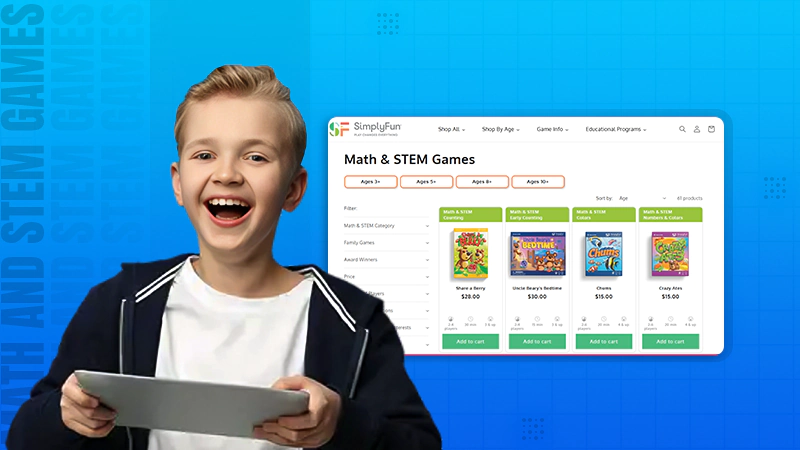By making difficult concepts approachable, enjoyable, and memorable, math and STEM games revolutionize classrooms. These captivating resources use play to help students from all backgrounds develop a deeper understanding and pique their curiosity.
When children are exposed to science and math through play-based scenarios, they have the chance to experiment, explore, and make mistakes in a safe setting.
Through play-based STEM games for elementary learners, teachers and parents can unlock new approaches to traditional learning, setting a foundation for future academic and career success.
Even hesitant learners are captivated by this immersive, hands-on experience, which turns lessons from dry, textbook exercises into unforgettable experiences that promote long-lasting understanding and confidence.
By moving game pieces, making decisions, and seeing the results of their decisions in real time, students transform from passive information consumers into active learners.
In this blog post, we are going to explore what makes these games engaging for young minds and motivated to master new concepts.
Let’s begin!
Key Takeaways
- Understanding how Math and STEM games enhance student engagement and understanding by making abstract concepts feel concrete and relevant.
- Decoding how these games develop critical thinking and problem-solving abilities, preparing learners for complex real-world challenges.
- Uncovering ways that games foster a positive attitude towards learning complex subjects, helping students build confidence, persistence, and enthusiasm.
Enhancing Engagement Through Interactive Play
With movement, strategy, and healthy competition, incorporating math and STEM games into the classroom stimulates young minds. These games’ interactive features draw players in and give abstract ideas a fun, tangible form.
Board games, digital science adventures, and number puzzles are examples of games that turn boring drills into engaging, hands-on experiences that appeal to a variety of learning styles, including kinesthetic, visual, and auditory learners.
For example, number puzzles and science adventure games transform routine exercises into dynamic experiences that appeal to all types of learners. Teachers often notice that students who struggle to stay focused during traditional lessons become more animated and involved when lessons are gamified.
According to Edutopia, playful approaches help students retain information and build positive associations with subjects that might otherwise seem intimidating. This excitement doesn’t just boost short-term engagement and motivates students to seek out further challenges, fostering an ongoing curiosity and enthusiasm for learning.
Interesting Facts
A significant 88% of teachers who use digital games in their classrooms report increased student engagement in learning. This high level of engagement translates into better focus, with one study finding that 93% of class time is effectively utilized during game-based learning sessions.
Developing Critical Thinking and Problem-Solving Skills
Educational games frequently demand that students do more than just memorize facts; they also ask them to evaluate information, think through several possible answers, and quickly adjust their tactics. Students are encouraged to try out various strategies rather than sticking to a set course, sometimes failing but always learning from the experience.
Many STEM games place players in situations where problem-solving is essential to advance, encouraging kids to persevere and think outside the box. This process mirrors real-world problem-solving and encourages independent thought.
Research shows that students who regularly engage in game-based problem-solving exercises tend to perform better on critical thinking assessments.
Recent studies, like those highlighted by The New York Times, show that even simple math games can boost critical thinking and reinforce concepts through repeated and varied challenges. In this way, games are not just reviewing material, but also building cognitive skills that will extend to future academic, professional, and life situations.
Fostering a Positive Attitude Towards Learning
When confronted with challenging material, many students feel anxious or frustrated, particularly in math classes where there may be a stigma associated with “right” and “wrong” answers.
By making learning feel like play and eliminating the anxiety of failure or embarrassment, presenting these subjects within a game framework reduces stress.
Errors are common in games and are valuable because they provide opportunities to improve and learn from past mistakes. Setbacks become low-stakes chances to try again, while successes are rewarded with points or game advancement.
This lays the foundation for a growth mindset a belief that ability can improve with effort rather than a fixed mindset that gives up in the face of difficulty. The result is a cycle that builds confidence, resilience, and a willingness to persevere through challenges.
Over time, students participating in game-based learning report enjoying learning activities more and feeling less anxious about tackling new academic material.
Connecting Learning to Real-World Applications
STEM games often simulate real-life scenarios or roles, showing children firsthand how concepts apply outside textbooks. For example, a math game with a space theme might ask students to determine the best course of action for landing a spacecraft safely, indirectly illustrating algebraic concepts that engineers and astronauts would find useful.
The same concepts that are practiced in these games—such as logical sequencing, estimation, and measurement—are used on a daily basis by businesses, physicians, and computer scientists.
Games reveal the practical side of abstract knowledge and fuel an intrinsic motivation to learn by giving students a sense of purpose for learning. Students develop a deeper appreciation for STEM fields and their practical value by connecting the dots between classroom knowledge and real-world challenges.
Personalized Learning Experiences
Adaptive algorithms are used by contemporary game-based platforms to customize learning experiences for every student, making sure that assignments are difficult enough to foster development without becoming too much. These tools are able to monitor development, pinpoint areas of strength and weakness, and modify content accordingly.
Whether a learner needs more practice on division or is ready to tackle advanced geometry, personalized games help maintain motivation and support mastery. Adaptive technology also allows teachers and parents to monitor progress in real-time, ensuring learners receive targeted support when necessary.
This individualized approach fosters ownership and responsibility in the learning process by enabling students to progress at their own speed. No matter where they start, the sense of accomplishment inspires and can transform underachieving students into self-assured achievers.
Encouraging Collaboration and Teamwork
Many math and STEM games are designed for groups, requiring communication and cooperation to succeed. Team-based challenges help children appreciate the power of collaboration, as group members work together to tackle complex problems and celebrate successes.
Students learn in these settings the value of sharing responsibilities, listening to others, and cooperating to achieve shared objectives. Cooperative games reinforce science and math concepts while teaching leadership, empathy, and teamwork. They also provide a unique combination of social and academic development.
Team-based games reinforce academic concepts and teach essential social and leadership skills that benefit children beyond the classroom, promoting positive relationships in both school and life.
Inspiring Lifelong Interest in STEM
When learning is fun, engaging, and relevant, students are more likely to remember and pursue those subjects into the future. Math and STEM games can spark passion in even the youngest learners by linking knowledge to personal interests—such as building structures, designing puzzles, or exploring the natural world.
From engineering and architecture to coding and scientific research, these activities expose students to STEM-related professions and pastimes. By tying education to real-world interests and abilities, math and STEM games ignite a passion and may lead students to pursue higher education or careers in engineering, technology, and other fields.
This feeling of accomplishment and discovery can set the stage for a lifetime of curiosity and success, ensuring that students continue to develop and innovate long after they graduate from school.
Final Thoughts
STEM and math games are revolutionizing teaching methods by changing the way kids engage with basic ideas. These games encourage academic achievement and a lifelong love of learning by making learning participatory, team-based, and applicable to everyday situations.
Integrating such tools in classrooms and at home equips students with the skills, confidence, and motivation they need to thrive in an ever-evolving world. As STEM education continues to grow in importance, these dynamic tools will help nurture the next generation of learners, thinkers, and innovators, ready to solve the challenges of tomorrow with creativity and resilience.
1. How effective is game-based learning in teaching mathematics?
Ans: Game-Based Learning can help students succeed academically and is a useful strategy for raising math engagement.
2. What is the importance of math in STEM?
Ans: It develops students’ mathematical process skills (reasoning, communication, problem-solving, and analytical thinking).
3. What are the 4 C’s of STEM education?
Ans: The Four Cs are: critical thinking, communication, collaboration, and creativity.





